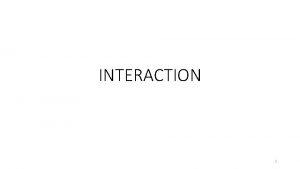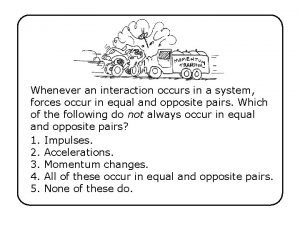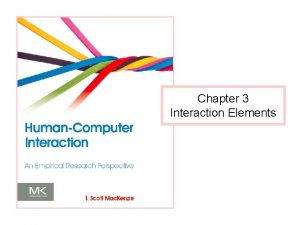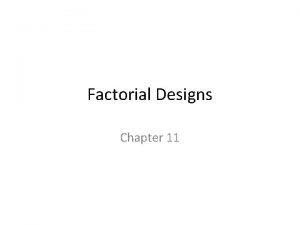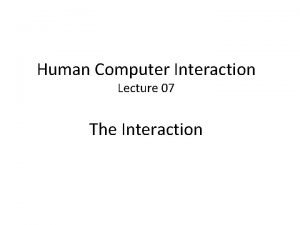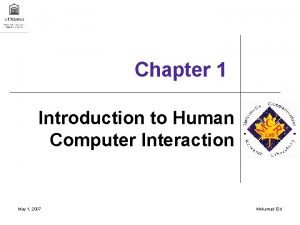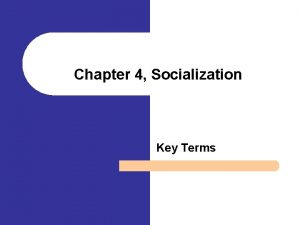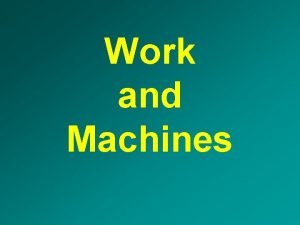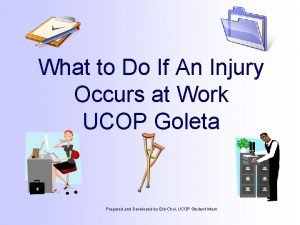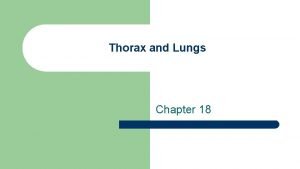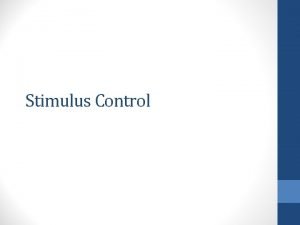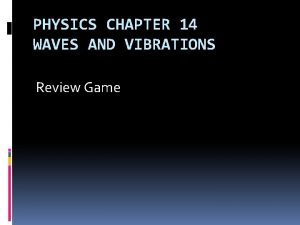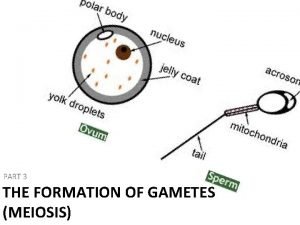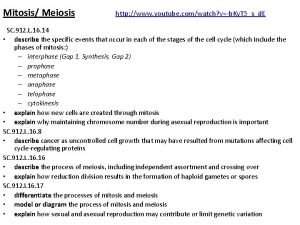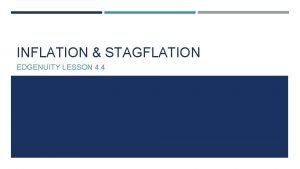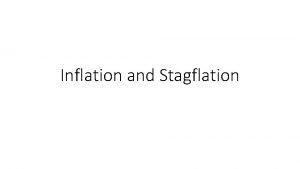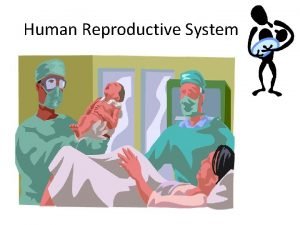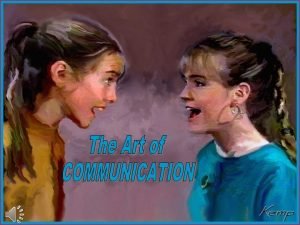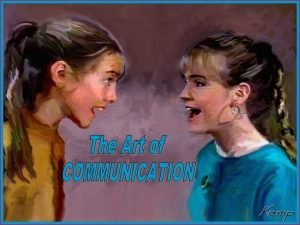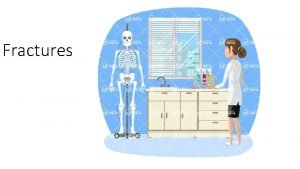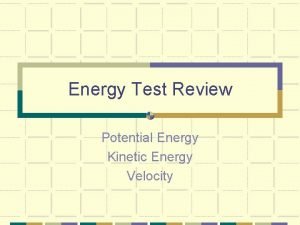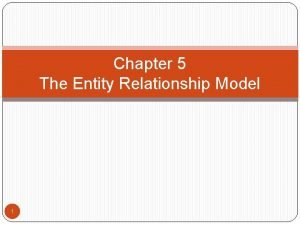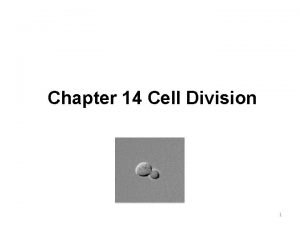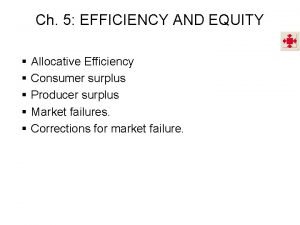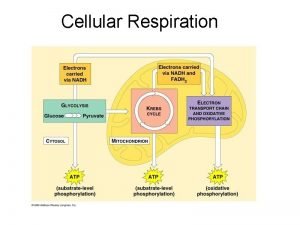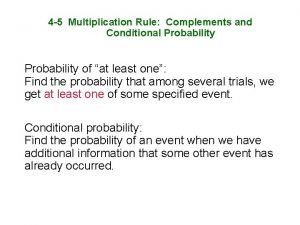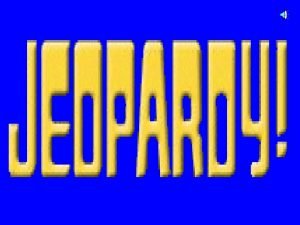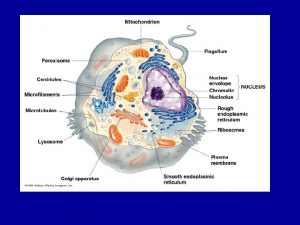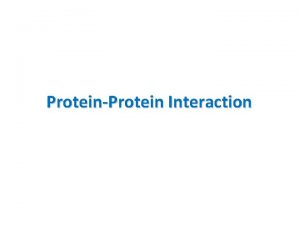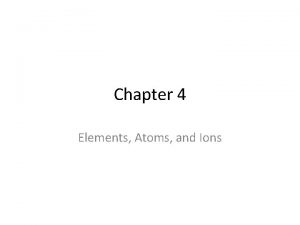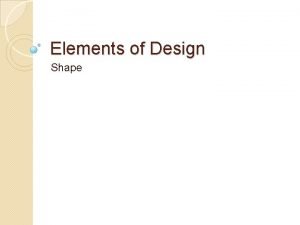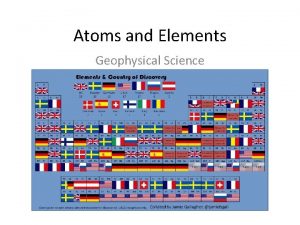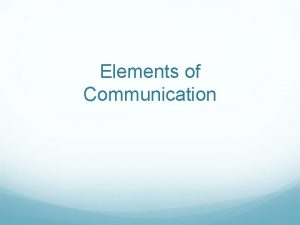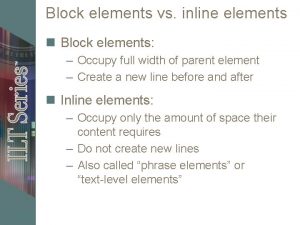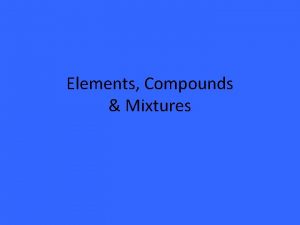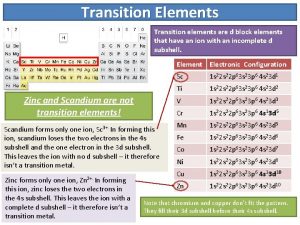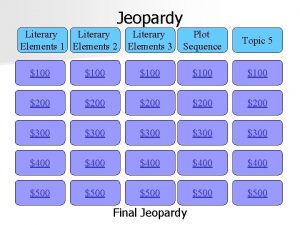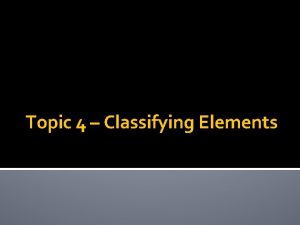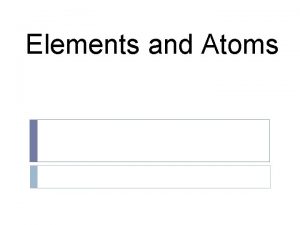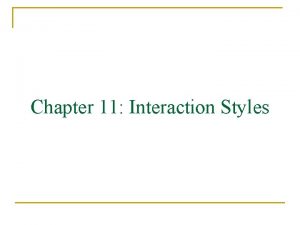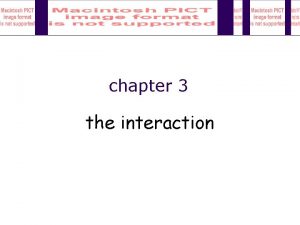Chapter 3 Interaction Elements Interaction Interaction occurs when



























































- Slides: 59

Chapter 3 Interaction Elements

Interaction • Interaction occurs when a human performs a task using computing technology • Interaction tasks with a goal: – – Send an e-mail Burn a CD Program a thermostat Enter a destination in a GPS device • Interaction tasks without a goal: – Browse the web – Chat with friends on a social networking site 2

Interaction Elements • Can be studied at many levels and in different contexts • As presented here, the tasks are in the cognitive band of Newell’s time scale of human action (see Chapter 2) – Deliberate acts ( 100 ms) – Operations ( 1 s) – Unit tasks ( 10 s) • Tasks in this range are well suited to empirical research • Experimental methodology preferred (extraneous behaviours easy to control) • Early human factors research on “knobs and dials” is relevant today • Knobs “controls”; dials “displays” (next slide) 3

Human Factors Model (revisited) Human Interface Sensors Computer Displays Brain Machine State Responders Controls 4

Hard Controls, Soft Controls • In the past, controls were physical, single-purpose devices hard controls • Today’s graphical displays are malleable • Interfaces created in software soft controls • Soft controls rendered on a display • Distinction blurred between soft controls and displays • Consider controls to format this (see below) Soft controls are also displays! 5

Scrollbar Slider • Example of a soft control (control + display) • As a control – Moved to change view in document • As a display – Size reveals view size relative to entire document – Position reveals view location in document 6

GUI Malleability • Below is a 30 cm 2 view into a GUI • >20 soft controls (or are they displays? ) • Click a button and this space is morphed into a completely different set of soft controls/displays 7

Control-Display Relationships • Also called mappings • Relationship between operation of a control and the effect created on a display • At least three types: – Spatial relationships – Dynamic relationships – Physical relationships 8

Spatial Relationships Natural Learned Spatial congruence Control: right Display: right Spatial transformation Control: forward Display: up 9

Axis Labeling Control Display 10

Third Tier 11

3 D • In 3 D there are 6 degrees of freedom (DOF) – 3 DOF for position (x, y, z) – 3 DOF for orientation ( x, y, x) In aeronautics… yaw roll pitch 12

Spatial Congruence in 3 D 13

3 D in Interactive Systems • Usually a subset of the 6 DOF are supported • Spatial transformations are present and must be learned • E. g. , Google Street. View 14

Panning in Google Street. View • (Switch to Google Street. View and demonstrate panning with the mouse) • Spatial transformations: Demo 15

CD Gain • Quantifies the amount of display movement for a given amount of controller movement • E. g. , CD gain = 2 implies 2 cm of controller movement yields 4 cm of display movement • Sometimes specified as a ratio (C: D ratio) • For non-linear gains, the term transfer function is used • Typical control panel to adjust CD gain: 16

CD Gain and User Performance • Tricky to adjust CD gain to optimize user performance • Issues: – Speed accuracy trade-off (what reduces positioning time tends to increase errors) – Opposing relationship between gross and fine positioning times: 17

Latency • Latency (aka lag) is the delay between an input action and the corresponding response on a display • Usually negligible on interactive systems (e. g. , cursor positioning, editing) • May be “noticeable” in some settings; e. g. , – Remote manipulation – Internet access (and other “system” response situations) – Virtual reality (VR) • Human performance issues appropriate for empirical research 18

VR Controllers • 6 DOF controllers common in VR and other 3 D environments • Considerable processing requirements • Lag often an issue • E. g. , Polhemus G 4™ (see below) • Lag specified as <10 ms (which is low) • But the user experiences the complete system 19

Property Sensed, Order of Control • Property sensed – Position (graphics tablet, touchpad, touchscreen) – Displacement (mouse, joystick) – Force (joystick) • Order of control (property of display controlled) – Position (of cursor/object) – Velocity (of cursor/object) 20

Joystick • Two types – Isotonic (senses displacement of stick) – Isometric (senses force applied to stick) Isotonic joystick Isometric joystick 21

Joysticks (2) • Optimal mappings – Isotonic joystick position control – Isometric joystick velocity control 22

Natural vs. Learned Relationships • Natural relationships spatially congruent • Learned relationships spatial transformation (relationship must be learned) Examples 23

Learned relationship Natural relationship 24

Learned Relationships • Learned relationships seem natural if they lead to a population stereotype or cultural standard • A control-display relationship needn’t be a spatial relationship… Is the display on or off? Answer: Canada) On (in U. S. , Off (in U. K. ) 25

Mental Models • Related terms: physical analogy, metaphor, conceptual models • Definition: a physical understanding of an interface or interaction technique based on real-world experience • Scroll pane: slider up, view up (“up-up” is a conceptual model that helps our understanding) • Desktop metaphor is most common metaphor in computing • Other commonly exploited real-world experiences: – Shopping, driving a car, calendars, painting • Icon design, in general, strives to foster mental models 26

Graphics and Paint Applications • Icons attempt to leverage real-world experiences with painting, drawing, sketching, etc. tooltips help for obscure features 27

Clock Metaphor • Numeric entry on PDA 1 • Users make straight-line strokes in direction of digit on clock face Mc. Queen, C. , Mac. Kenzie, I. S. , & Zhang, S. X. (1995). An extended study of numeric entry on penbased computers. Proceedings of Graphics Interface '95, 215 -222, Toronto: Canadian Information 28 Processing Society. 1

Clock Metaphor (2) • Blind users carry a mobile locating device 1 • Device provides spoken audio information about nearby objects (e. g. “door at 3 o’clock”) Sáenz, M. , & Sánchez, J. (2009). Indoor position and orientation for the blind. Proceedings of HCI International 2007, 236 -245, Berlin: Springer. 1 29

Modes • A mode is a functioning arrangement or condition • Modes are everywhere (and in most cases are unavoidable) • Office phone light: on = message waiting, off = no messages • Computer keyboards have modes – 100 keys + SHIFT, CTRL, ALT 800 key variations 30

F 9 – Microsoft Word (2010) • At least six interpretations, depending on mode: F 9 Update selected fields SHIFT+F 9 Switch between a field code and its result CTRL+F 9 Insert an empty field CTRL+SHIFT+F 9 Unlink a field ALT+F 9 Switch between all field codes and their results ALT+SHIFT+F 9 Run GOTOBUTTON or MACROBUTTON from the field that displays the field results 31

International Keyboards • Some keys bear three symbols • How to access the third symbol? • German keyboard example: 32

Mobile Phone Example • Navi key (first introduced on Nokia 3210) • Mode revealed by word above • At least 15 interpretations: Menu, Select, Answer, Call, End, OK, Options, Assign, Send, Read, Use, View, List, Snooze, Yes 33

Contemporary LCD Monitor • • Similar to Navi key idea No labels for the four buttons above power button Function revealed on display when button pressed Possibilities explode 34

Mode Switching • • • Power. Point: Five view modes Switch modes by clicking soft button Current mode apparent by background shading Still problems lurk How to exit Slide Show mode? – Power. Point ESC – Firefox ? 35

Mode Switching (2) • Sports watch • Single button cycles through modes 36

Mode Visibility • Shneiderman: “offer information feedback” 1 • Norman: “make things visible” 2 • unix vi editor: Classic example of no mode visibility: Shneiderman, B. , & Plaisant, C. (2005). Designing the user interface: Strategies for effective humancomputer interaction. (4 th ed. ). New York: Pearson. 37 2 Norman, D. A. (1988). The design of everyday things. New York: Basic Books. 1

Mode Visibility (2) • Insert vs. Overtype mode on MS/Word • Some variation by version, but the user is in trouble most of the time 38

Modes and Degrees of Freedom • If control DOF < display DOF, modes are necessary to fully access the display DOF • Consider a mouse (2 DOF) and a desktop display (3 DOF) • x-y control (no problem): but… 39

• Rotation is a problem: 40

Rotate Mode • The solution: Rotate mode • Two approaches – Separate rotate mode: – Embedded rotate mode: Could be avoided with… 41

3 DOF Mouse • Lots of research: 1 2 3 • But no commercial products (yet!) Almeida, R. , & Cubaud, P. (2006). Supporting 3 D window manipulation with a yawing mouse. Proc Nordi. CHI 2006, 477 -480, New York: ACM. 2 Mac. Kenzie, I. S. , Soukoreff, R. W. , & Pal, C. (1997). A two-ball mouse affords three degrees of freedom. Proc CHI '97, 303 -304, New York: ACM. 3 Hannagan, J. , & Regenbrecht, H. (2008). Twist. Mouse for simultaneous translation and rotation. Tech 42 Report. HCI Group. Information Science Department. University of Otago, Dunedin, New Zeland. 1

3 D Rotation • Mapping controller x-y to display x- y- z • Very awkward (to be polite) Demo [click here] to open Excel spreadsheet (3 DRotation. Example. xlsx) 43

>2 Degrees of Freedom • Examples in the HCI research literature • 4 DOF Rockin’ Mouse 1 • Three-axis trackball 2 Balakrishnan, R. , Baudel, T. , Kurtenbach, G. , & Fitzmaurice, G. (1997). The Rockin'Mouse: Integral 3 D manipulation on a plane. Proc CHI '97, 311 -318, New York: ACM. 2 Evans, K. B. , Tanner, P. P. , & Wein, M. (1981). Tablet based valuators that provide one, two, or three 44 degrees of freedom. Computer Graphics, 15(3), 91 -97. 1

Separating the Degrees of Freedom • More DOF is not necessarily better • Must consider the context of use • Etch-A-Sketch: separate 1 DOF x and y controllers: 45

Wheel Mouse • Separate DOF via a wheel • Successful introduction by Microsoft in 1996 with the Intelli. Mouse • Preceded by… Roller. Mouse 1 Pro. Agio 2 Venolia, D. (1993). Facile 3 D manipulation. Proc CHI '93, 31 -36, New York: ACM. 2 Gillick, W. G. , & Lam, C. C. (1996). U. S. Patent No. 5, 530, 455. 1 46

Adding a Touch Sensor Panning and Zooming Display 2 Pad. Mouse 1 Top view Bottom view Multitouch+Mouse 3 Balakrishnan, R. , & Patel, P. (1998). The Pad. Mouse: Facilitating selection and spatial positioning for the non-dominant hand. Proc CHI '98 (pp. 9 -16): New York: ACM. 2 Silfverberg, M. , Korhonen, P. , & Mac. Kenzie, I. S. (2003). International Patent No. WO 03/021568 A 1. 3 Villar et al. (2009). Mouse 2. 0: Multi-touch meets the mouse. Proc UIST ‘ 09, 33 -42, New York: ACM. 47 1

Mobile Context • Touchscreens are the full embodiment of direct manipulation • No need for a cursor (cf. indirect input) 48

Touch Input Challenges • Occlusion and accuracy (“fat finger problem”) • Early research Offset cursor 1 • Contemporary systems use variations; e. g. , offset animation: Potter, R. , Berman, M. , & Shneiderman, B. (1988). An experimental evaluation of three touch screen 49 strategies within a hypertext database. Int J Human-Computer Interaction, 1 (1), 41 -52. 1

Multitouch 50

Multitouch (>2) 51

Accelerometers • Accelerometers enable tilt or motion as an input primitive • Technology has matured; now common in mobile devices • Many applications; e. g. , spatially aware displays: 52

Interaction Errors • Discussions above focused on physical properties of controllers and the interactions they enable • Interaction involves the human (sensors, brain, responders) and the machine • Interaction errors are unavoidable (and, hence, are akin to an “interaction element”) • We conclude with a look at interaction errors and their consequences • Themes: (see HCI: ERP for discussion) – Big, bad errors are high in consequences and therefore get a lot of attention – Little errors are low in consequences and therefore tend to linger – There is a continuum 53

Discard Changes • Default dialogs to quit an application: 54

CAPS_LOCK • Some log-in dialogs alert the user if CAPS_LOCK is on… • while others do not… 55

Scrolling Frenzy • Drag to select a range of text • As the dragging extent approaches the edge of the scroll pane, the user is venturing into a difficult situation 56

Focus Uncertainty • After entering data into a fixed-length field, some interfaces advance focus the next field… • while others do not… www. serviceontario. ca 57

Cost vs. Frequency of Errors • Message: High frequency / low cost errors are the most interesting • They… – Have evaded the scrutiny of designers – Keep users on guard 58

Thank You 59
 An interaction occurs when:
An interaction occurs when: An interaction occurs whenever:
An interaction occurs whenever: An interaction occurs whenever:
An interaction occurs whenever: 11 factorial
11 factorial Elements of the wimp interface
Elements of the wimp interface Literary elements in drama
Literary elements in drama Elements and sub elements
Elements and sub elements Hydrosulfuric acid
Hydrosulfuric acid Http //elements.wlonk.com/elements table.htm
Http //elements.wlonk.com/elements table.htm What is folktale
What is folktale Features and themes of african folktales
Features and themes of african folktales Human computer interaction chapter 1
Human computer interaction chapter 1 Chapter 4: socialization, interaction, and the self
Chapter 4: socialization, interaction, and the self What is the force distance trade off
What is the force distance trade off When a serious customer injury occurs
When a serious customer injury occurs Increased tactile fremitus occurs with
Increased tactile fremitus occurs with How to determine if a single replacement reaction occurs
How to determine if a single replacement reaction occurs Discriminatory stimuli
Discriminatory stimuli Gas exchange oxygen transport
Gas exchange oxygen transport Snell's law
Snell's law _____ occurs when waves bend around a barrier.
_____ occurs when waves bend around a barrier. What is the opposite of photosynthesis
What is the opposite of photosynthesis Mitosis and meiosis
Mitosis and meiosis Saltatory conduction occurs in
Saltatory conduction occurs in Independent assortment in meiosis
Independent assortment in meiosis Metallic bonding occurs between atoms of
Metallic bonding occurs between atoms of Photorespiration occurs principally because of
Photorespiration occurs principally because of Duo servicekantoor
Duo servicekantoor Dna polymerase
Dna polymerase Reabsorption in the nephron occurs in the
Reabsorption in the nephron occurs in the Dramatic irony def
Dramatic irony def Typically, low inflation is a sign of
Typically, low inflation is a sign of Inflation causes
Inflation causes Introduction of inflation
Introduction of inflation Stagflation define
Stagflation define When neither allele is dominant
When neither allele is dominant Human reproductive system
Human reproductive system Fertilization occurs
Fertilization occurs Stagflation occurs when high inflation combines with
Stagflation occurs when high inflation combines with Good communication occurs when a
Good communication occurs when a Communication occurs when two
Communication occurs when two Break in continuity
Break in continuity What energy transformation occurs in a burning match?
What energy transformation occurs in a burning match? Competitive exclusion occurs when _______.
Competitive exclusion occurs when _______. Rating error
Rating error The initial operational capability milestone occurs
The initial operational capability milestone occurs Define genuine agreement
Define genuine agreement Existence dependent
Existence dependent Tactile fremitus increased
Tactile fremitus increased Cell continuity definition
Cell continuity definition Conflict occurs whenever
Conflict occurs whenever Crossing over during prophase 1
Crossing over during prophase 1 Allocative efficiency occurs when
Allocative efficiency occurs when Etc occurs in
Etc occurs in Glycolysis occurs in the
Glycolysis occurs in the Where does cellular respiration take place
Where does cellular respiration take place Nonsister chromatids
Nonsister chromatids The elizabethan audience believed that evil occurs where?
The elizabethan audience believed that evil occurs where? Conditional probability with complements
Conditional probability with complements Which moon phase occurs directly before a new moon
Which moon phase occurs directly before a new moon
